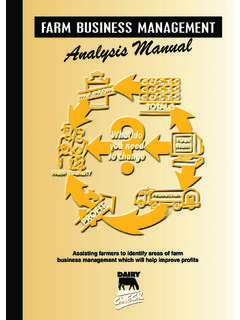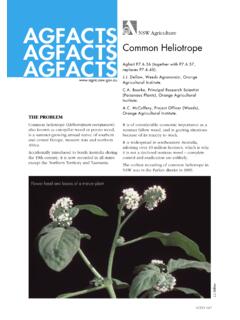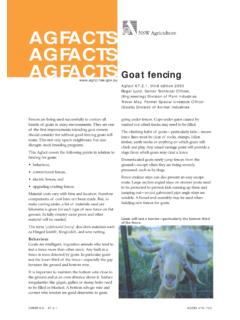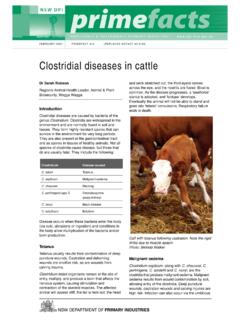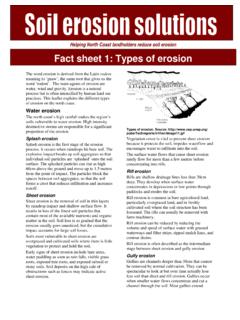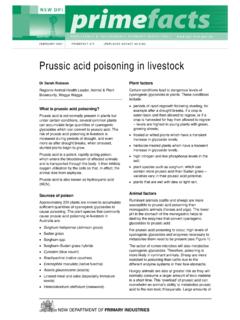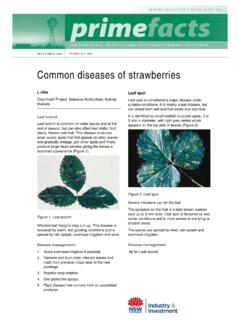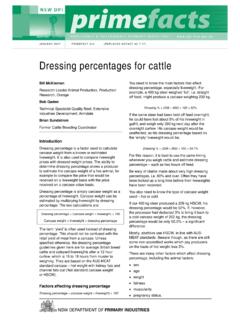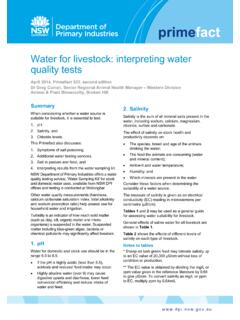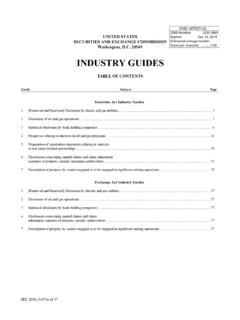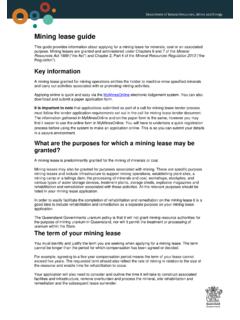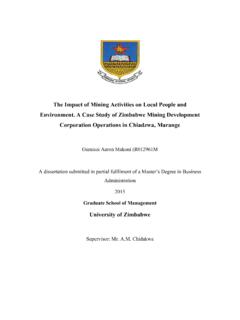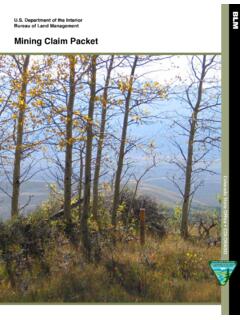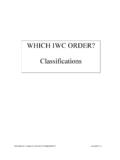Transcription of Mining by Aborigines - Australia's first miners
1 FEBRUARY 2007 PRIMEFACT 572 (REPLACES MINFACT 84). Mining by Aborigines Australia's first miners Mineral Resources While 1997 was the bicentenary of Mining in Australia by people of European descent, the history of Mining in this country stretches back much further. For more than 40 000 years before the arrival of the first Fleet in Sydney Harbour, Australian Aborigines had been Mining the land for ochre and stone. Aborigines depended on their stone implements to gather and process their food; ochre was a vital ingredient in art and religious practices; quarries and processing' sites were developed to cater for Ochre was mined by Aborigines for use in cave and the demand for these products; and transport body painting and for the decoration of artefacts. routes were established to allow for their trade. Ochre figures from a cave near Cobar While ochre and stone of one sort or another can The quarried flint nodules from the cave were taken be found almost anywhere in Australia, the ochre elsewhere to be made into tools.
2 And stone deposits that were exploited by Aborigines were of particularly high quality. Operations at most major Aboriginal mines appear to have ceased no later than 50 years ago, The higher the quality, the larger the Mining although deposits of ochre are still being exploited operation and the greater the distance over which for use in art and ceremonies. the product was traded. Ochre from north western South Australia and from eastern Western Australia There are 416 recorded Aboriginal mine sites in and stone axes from Mount Isa-Cloncurry were eastern Australia (Queensland, NSW, Victoria), traded far outside these districts. At times many although new sites are being identified all the time. different clans would gather near a quarry site to In NSW there are 183 identified sites (144 stone trade for the stone or ochre and to hold quarries and 17 ochre mines, with no information, ceremonies, initiations and other important cultural beyond location, being available for the remaining events.)
3 22). Ownership of mines rested with the clan on whose land they occurred and access to them was Ochre allowed only with the permission of these Ochre is iron oxide. It is found in a range of custodians. Within a clan, the actual Mining was colours, from yellow through to red and brown. The often undertaken by a smaller group who had ochre ore' is ground to a powder and then wetted, special knowledge of how to correctly extract the usually with water but sometimes saliva, blood, the resource. fat of fish, emu, possum or goanna, or with orchid Mines were generally open cut, although some juice for a fixative. The resulting pigment is used for mines did extend underground. At Koonalda Cave cosmetics, body and artefact decoration, and cave in South Australia there is evidence that flint Mining painting. extended about 75 metres below the surface and Dry ochre is used for staining skins and in hair.
4 Up to 300 metres from the entrance of the cave. Red ochre has great significance to desert cultures, who believe it to be the blood of ancestral beings. Because of this it is thought to cure, protect and strengthen. Ochre was traded widely from the main ochre quarries. Aboriginal groups travelled from Cloncurry in Queensland to the Yarrakina ochre mine at Parachilna in the Flinders Ranges in South Australia to exchange shields for the special iridescent ochre mined there. Other groups from NSW exchanged light spear shafts for the prized ochre. Aborigines also came from Alice Springs in the Northern Territory, carrying 25 kg blocks of the Yarrakina ochre over distances of 1000 km on their return journey. Ochre from near Mount Rowland in Tasmania was mined by Aboriginal women using stone hammers and wooden chisels. The ochre was then packed into kangaroo-skin bags for transport.
5 The Wilgie Mai mine east of Geraldton in Western Australia was a major operation with a Mining face of between 30 and 15 metres wide and up to 20. metres deep. The red and yellow ochre from the mine was excavated by men using heavy stone mauls and fire-hardened wooden wedges up to half a metre long. Pole scaffolding was erected for working at different heights. Several thousand tonnes of rock were removed from this mine. Wilgie Mai is considered a place of fabulous wealth' by Aborigines in the west and ochre from the mine was used in a huge area of Western Australia and may have been carried as far as Queensland. The Rumbalara deposit 200 km south of Alice Springs in the Northern Territory has also been a large producer of ochre. During the Second World War, the ochre from Rumbalara was used for the manufacture of camouflage paint. The discovery of the vast Cobar copper and gold deposits in NSW has a connection to the Mining of ochre by Aborigines .
6 The presence of copper was first noticed at a waterhole at what is now Cobar. This waterhole was a meeting place for local clans, who used ochre from the same spot in their ceremonies. Stone Stone was of vital importance to Aborigines . It was used in the hunting and gathering of food and in food preparation and processing. Ochre cave paintings. Top, hands from a cave Stone tools older than 40 000 years have been north of Ulan in the Central West. Below, figures found in the north and east of Australia. Tools were from a cave near Cobar made by flaking', grinding' and crumbling' and Axes and other cutting tools were typically made were used for cutting, for caving and crafting wood, from volcanic and metamorphic rocks, which are for grinding seed and for making new stone hard and tough. Millstones and other grinding tools implements and other tools. PRIMEFACT 572, Mining BY Aborigines - Australia's first miners 2.
7 Were usually made of softer rock such as Mount William, near Lancefield in Victoria, was the sandstone. site of a large Aboriginal quarry that extended for over a kilometre along a ridge. The stone being Types of rock mined by Aborigines included exploited is a volcanic greenstone, which is hard amphibolite, andesite, basalt, blue metal, and has a fine grain, making it ideal for the chalcedony, chert, diabase, granite, greenstone, production of stone axes with a ground-edge. greywacke, ironstone, limestone, mudstone, obsidian, porphyry, quartz, quartzite, sandstone, In Western Australia, sharp-edged stones from the silcrete, silicified stone, siltstone and trachyte. Murchison River area were traded over an area of almost 1000 square kilometres to the south. The stone most frequently quarried in NSW was silcrete, with chert, quartz and quartzite extraction also being relatively common.
8 Stone was mined from boulders, exposed veins or blocks, conglomerates and from gibber and deposits of pebbles/cobbles and gravel. Mining was by extraction from surface deposits and by excavation below the surface. Work at an Aboriginal quarry would have consisted of the extraction and rough trimming of blanks' . pieces of a convenient size and shape for making into axes. Final trimming of the axe and grinding of the blade was often done elsewhere. Sites for the finishing' of stone tools were widely scattered and the tools were widely traded. Axes have been shown to have been traded 600-700 km from their source, and some as far as 800 km. In NSW, flaked and ground-edge pebble axes were made at Emu Plains, west of Sydney. High-quality quartzite from a site between Long Bay and Maroubra Bay in Sydney's south was used to make skinning knives. Ground-edge axes from Mounts Harris and Forster near Dubbo were traded as far north as Brewarrina and east to the Bogan River.
9 Chert (a flint-like quartz) was obtained from Newcastle and surrounds. Stone from Crescent Head and Point Plomer on the north coast was used to make tools. Ground-edge axes were transported down the Paroo River to the Wilcannia district. Axes made Top, Aboriginal silcrete quarry on an isthmus on the from metamorphic rock from the Barrier Ranges western shore of Lake Mungo in the Far West of have been found near Menindee and further south. NSW. Below, detail showing debris from tool Clans from the upper Darling River traded stone making. mortars and pestles for nets, twine and fish hooks with the clan of the Darling-Murray River junction. References Stone axes from the Hastings-Tweed Rivers region on the north coast and from quarries on the All information in this sheet has been sourced from northern tableland were traded for hundreds of the following references: kilometres across to the Darling River and as far Andrews, , 1911, Report on the Cobar west as Menindee and Broken Hill.
10 Copper and Gold-Field, New South Wales The Moore Creek quarry near Tamworth was the Department of Mines, Geological Survey, largest in the New England region. Stone from a Sydney greywacke deposit which runs for about 90 metres Flood, J., 1983, Archaeology of the Dreamtime, along a ridge was removed in large amounts from William Collins Pty Ltd, Sydney this site. Hiscock, P. and Mitchell, S., 1993, Stone Artefact Other Aboriginal quarries in NSW were located at Quarries and reduction Site in Australia: Towards Grogin Peak, Lowes Mount, Mission Cove, a Type Profile, Australian Heritage Commission, Schnapper Point, Yamba Point and Wilsons Peak. PRIMEFACT 572, Mining BY Aborigines - Australia's first miners 3. Aborigines used stone for building as well as for manufacturing tools. These stone fish traps were photographed on the Barwon River near Brewarrina by Pittman between 1874 and 1881.
